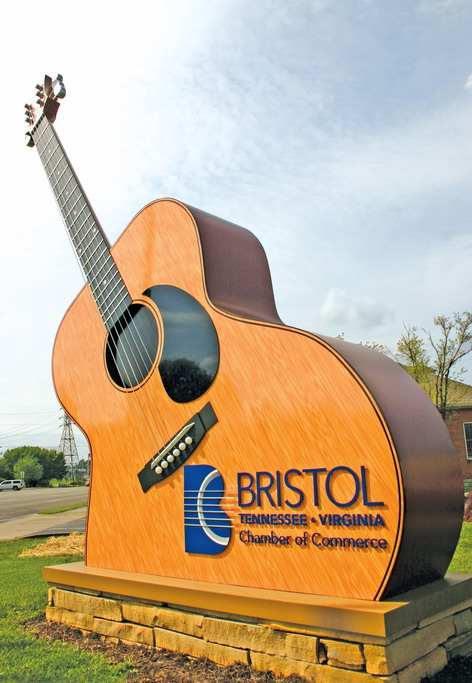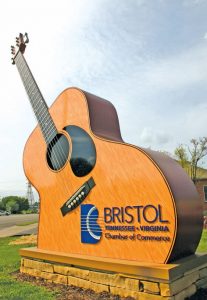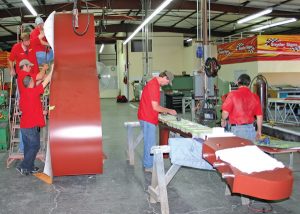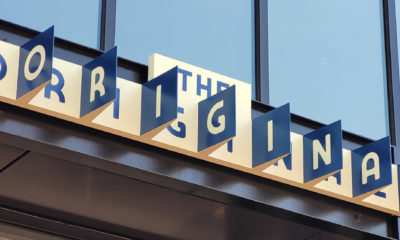To commemorate its 100th anniversary, the Bristol (TN and VA) Chamber of Commerce wanted to create an iconic tribute. The area’s musical heritage provided an easy answer. Victor Records recorded many of the region’s traditional folk-music artists, most notably the legendary Carter family, in Bristol, which earned it the nickname “The Birthplace of Country Music” (country legend Tennessee Ernie Ford also hails from Bristol).
Thus, a monument that features a behemoth, acoustic guitar proved a fitting testament to local history. The chamber hired Johnson City, TN-based Snyder Signs to undertake the job. Although the inspiration might have arrived simply, the 22-ft.-tall guitar’s production required hard work, exacting attention to detail and more than 700 hours of labor.
Taking shape
Although both Bristols maintain independent governments, the chamber serves both communities because of their intertwined identity. Downtown’s State St. serves as the line of demarcation, and the cities’ iconic gateway sign proudly decrees the joint Bristol communities “a good place to live.”
Lisa Meadows, the Bristol Chambers’ president, received inspiration for the iconic monument during a visit to Cleveland. To celebrate the 100th anniversary of Cleveland’s Rotary Club, the group commissioned the production of several replica guitars, which were set in concrete and installed between the Rock and Roll Hall of Fame and the Cleveland Science Museum.
When she returned to Bristol, she coordinated the formation of a chamber committee to explore the development of a monument to celebrate its milestone. She approached Thompson & Litton, a structural-engineering firm with an office in Bristol, TN, to develop conceptual drawings for several potential themes. Several themes, such as a fountain or an auto-racing themed sculpture (the Bristol Motor Speedway and Bristol Dragway feature several NASCAR and NHRA events annually), were considered. However, Meadows said the group reached an easy consensus that the city’s country-music heritage should be the monument’s focal point.
Scott Wilson, Thompson & Litton’s project manager, credits Emily Hope, an architectural student interning at the firm, with conceiving the idea from scratch. Needed were durable materials that would stand up to the Appalachian Valley’s changeable climate, yet still authentically resemble a guitar. The chamber’s property, which fronts a busy, four-way intersection, provided an ideal location.
Advertisement
With Thompson & Litton’s blueprint in hand, the chamber hired Snyder Signs to fabricate the behemoth sculpture. Wilson said, “We’ve worked with Snyder Signs in the past, and they’re always eager to tackle unusual and creative projects.”
Initially, Hope’s schematic appeared translucent, but Snyder adapted the sculpture to resemble a traditional, acoustic guitar – fitting for the region’s homespun musical style. To avoid copyright-infringement snags, Snyder eschewed fashioning the guitar after a particular style and created a generic model, according to Randy Holland, Snyder’s operations manager.
To design the 22-ft.-tall, approximately 1,000-lb. sign, Snyder refined the concept with CorelDraw 14 and SA Intl.’s FlexiSign 8. To prepare the file for the shop’s Techno LC CNC router, Snyder’s design team used Aries Graphics’ Sign Wizard software and, for the fretboard and other complex, 3-D elements, they used 3D Max. They prefer both programs because of their versatility, Holland said.
If you build it…
Holland said scaling the guitar’s different components to appear realistic provided a significant challenge. Thus, the project required extensive engineering to build strong, durable components. Snyder also tweaked the project by building a protruding monument for the guitar; the original drawings called for a guitar that seemingly arose from the ground.All told, Snyder devoted five weeks to building and installing the sign.
To dig the 30-in.-diameter, 8-ft.-deep foundation, Snyder used a Bobcat excavator with a 30-in. auger. To bolster it, they installed a rebar cage and four, 6-ft.-long anchor bolts.
The guitar’s “skeleton” comprises 0.125-in.-thick aluminum, which Snyder either roll-formed or cut to shape with its Techno LC Series 59120 CNC router.
To build the fretboard, Snyder used ¼-in.-thick, aluminum plate, which they cut to shape with a Universal Laser 45W cutter. The shop also used ¼-in. aluminum to fashion the fretboard and frets. To bond the frets to the structure, Snyder used two-part epoxy. Constructing the 10-ft.-long neck required layering and laminating ½-in.-thick plywood slabs before filling in the edges and spraying on a fiberglass coating. After having sprayed Marhyde primer over the fiberglass, they sprayed on Matthews satin, acrylic-polyurethane paint.
To replicate inlaid-pearl markers along the fretboard edges, fabricators used hand tools to fashion round, acrylic pieces. They coated the pieces with white, Matthews paint. Snyder also crafted the tuning keys by hand from 0.125-in. aluminum.
Of course, the strings represented a key structural component. After having evaulated the strength required, Snyder installed heavy-gauge aircraft cable. And, if any onlookers decide to strum the behemoth monument, they won’t be disappointed – the cables make a melodic sound.
Advertisement
To craft the guitar’s 150-sq.-ft., wood-grain face, Snyder used 3M’s Comply v3 air-egress film, which it decorated on its Mimaki JV3 250-SP Baby Grand solvent-ink printer with SS2 inks. To fine-tune the image, the shop used FlexiSign Pro 7.6. To make the wood-grain image appear authentic, the design team scanned a wood-grain pattern into the program and modified it to scale.
And they came
Although Snyder Sign’s guitar required city-issued permits, the project’s approval sailed through unabated. More than 50 of the chamber’s Gold Club members funded the project.
Onsite, Snyder used a bucket truck and a 23-ton Terex crane truck to assemble the guitar. The shop transported the sign’s unassembled components on a trailer and mechanically fastened the neck and body together onsite.
Meadows said installers hadn’t yet finished fastening the bolts when onlookers began taking pictures. “The first group I talked to was a family from New Zealand. They were vacationing in the States, had heard about the guitar and decided to stop in Bristol for a few days. We’re very proud that our town, and our Chamber of Commerce, are home to such a unique sign.”


 Real Deal2 weeks ago
Real Deal2 weeks ago
 Projects2 weeks ago
Projects2 weeks ago
 News3 days ago
News3 days ago
 Projects3 days ago
Projects3 days ago
 Business Management2 weeks ago
Business Management2 weeks ago
 How To14 hours ago
How To14 hours ago
 News2 weeks ago
News2 weeks ago
 Manager's To Do1 week ago
Manager's To Do1 week ago


















